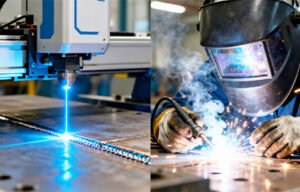How to Properly Operate a Handheld Laser Welding Machine: A Comprehensive Guide
A handheld laser welding machine is a versatile tool used across various industries to weld metal parts with precision and efficiency. Unlike traditional welding methods, a laser welding machine uses focused laser beams to create high-intensity heat that melts and fuses materials. While the process is highly efficient, it is essential to operate the machine correctly to ensure safety, achieve the desired results, and maintain the longevity of the equipment.
In this guide, we will walk you through the proper steps for operating a handheld laser welding machine, including essential safety measures, tips for beginners, and advice on how to choose the right machine for your needs.
What Is a Handheld Laser Welding Machine?
A handheld laser welding machine is a portable device that allows you to perform precise welding on various materials. Unlike fixed-position welding machines, handheld models are designed for ease of use and mobility, making them ideal for on-site welding jobs or projects that require flexibility.
The machine uses a high-powered laser beam to heat and melt materials, fusing them together to create a strong and durable bond. The beam’s intensity and focus are adjustable, allowing the operator to control the heat distribution and achieve different welding effects.
Key Components:
Laser source: Produces the laser beam used for welding.
Handheld welding head: The part the operator uses to direct the laser at the workpiece.
Cooling system: Ensures the machine stays at the optimal temperature during operation.
Power supply: Provides the necessary power for the laser to function.
Applications:
Handheld laser welders are widely used in industries such as automotive, aerospace, jewelry, electronics, and metalworking. Their precision and efficiency make them particularly useful for welding thin metals, delicate components, and hard-to-reach areas.
Safety Precautions When Using a Handheld Laser Welding Machine
Operating a handheld laser welder involves working with high-powered lasers that can cause serious injuries if not handled properly. To ensure your safety and that of others around you, follow these essential safety precautions:
Personal Protective Equipment (PPE): Always wear appropriate PPE, including laser safety goggles, gloves, and protective clothing, to shield yourself from laser radiation and heat.
Workspace Safety: Ensure that your workspace is well-ventilated and free of flammable materials. Maintain a clean and organized environment to avoid accidents.
Laser Radiation Safety: Always be mindful of the laser beam’s direction. Never point the laser directly at people or reflective surfaces, as it can cause serious eye damage.
Step-by-Step Guide for Operating a Handheld Laser Welding Machine
Operating a handheld laser welding machine may seem complex at first, but with the right knowledge and technique, it becomes an efficient and manageable task. Here’s a step-by-step guide to help you get started:
Preparing the Machine: Before starting, ensure that the machine is properly set up, powered on, and ready for use. Make sure that all safety precautions are in place.
Adjusting Settings for Different Materials: Handheld laser welders are capable of welding various materials, including stainless steel, aluminum, copper, and more. Adjust the power and speed settings according to the material and thickness you are working with.
Proper Welding Techniques: Hold the machine steadily and focus the laser beam on the welding area. Move the handheld welding head smoothly along the joint, ensuring an even weld.
Post-Welding Process: After completing the weld, allow the material to cool down before handling it. Inspect the weld for any defects or imperfections, and make adjustments if necessary.
Common Mistakes to Avoid When Using a Handheld Laser Welding Machine
While handheld laser welders are easy to use, beginners may make certain mistakes that can lead to poor results or safety issues. Here are some common mistakes to avoid:
Incorrect Settings: Setting the wrong power level, speed, or focus can lead to weak welds, burn marks, or material damage. Always adjust the settings based on the material and thickness you are working with.
Inadequate Preparation: Not cleaning the welding area or not securing the workpiece properly can result in poor weld quality. Always clean the surfaces before welding and secure the material in place.
Poor Handling Techniques: Uneven movements or inconsistent speed can cause the weld to be uneven. Practice steady, smooth movements to achieve consistent and strong welds.
Advantages of Using a Handheld Laser Welder
Using a handheld laser welding machine offers several advantages over traditional welding methods:
Precision and Efficiency: Handheld laser welders offer high precision and can create very fine, detailed welds. They are also highly efficient, reducing the need for post-welding work.
Portability and Ease of Use: Their lightweight and portable design make them ideal for on-site welding jobs or applications where mobility is essential.
Cost Savings in Long-Term Operations: Although the initial investment may be higher, the energy efficiency and low maintenance costs of handheld laser welders make them a cost-effective choice in the long run.
How to Choose the Right Handheld Laser Welding Machine for Your Business
When choosing a handheld laser welding machine, consider the following factors:
Power and Size: Choose a machine with the right power capacity for your welding needs. Smaller, lower-power machines are suitable for delicate or small-scale applications, while larger machines are needed for heavy-duty tasks.
Material Compatibility: Ensure that the machine can weld the materials you commonly work with, such as steel, aluminum, or titanium.
Cost vs. Value: Consider the overall value of the machine, including its durability, efficiency, and the types of welds it can create.
Maintenance and Care for Handheld Laser Welding Machines
Regular maintenance is essential to ensure that your handheld laser welding machine continues to perform at its best. Here are some tips for maintaining your equipment:
Regular Inspection and Cleaning: Check the machine regularly for wear and tear, and clean it after each use to prevent debris from building up.
Troubleshooting Common Issues: Familiarize yourself with common problems and how to troubleshoot them. For example, if the laser beam is not focusing properly, check for dirt on the lens.
Ensuring Longevity: Perform regular servicing and follow the manufacturer’s guidelines for maintenance to extend the life of your machine.
Conclusion
Properly operating a handheld laser welding machine is key to achieving high-quality, precise welds. By following the steps outlined in this guide and taking necessary safety precautions, you can maximize the performance of your machine and ensure successful results. Always remember to choose the right machine for your needs, practice proper techniques, and maintain your equipment to enjoy the benefits of handheld laser welding for years to come.
111-1024x458.png)


